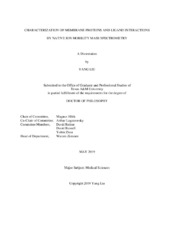| dc.contributor.advisor | Hook, Magnus | |
| dc.contributor.advisor | Laganowsky, Arthur | |
| dc.creator | Liu, Yang | |
| dc.date.accessioned | 2019-10-16T19:37:01Z | |
| dc.date.available | 2019-10-16T19:37:01Z | |
| dc.date.created | 2019-05 | |
| dc.date.issued | 2019-04-18 | |
| dc.date.submitted | May 2019 | |
| dc.identifier.uri | https://hdl.handle.net/1969.1/184960 | |
| dc.description.abstract | Membrane proteins interact intimately with the lipid bilayer in which they are embedded. Interactions between membrane proteins and ligands such as lipids and other small molecules can affect protein structure and function. Ion mobility-mass spectrometry (IM-MS) has recently emerged as a valuable tool for interrogating the interactions between protein and individual ligands, offering direct measurements such as stoichiometry, molar intensities and gas-phase mobility for each ligand-bound state of a protein complex. This technique is applied to examine the effect of direct ligand binding on model membrane proteins, such as the ammonium channel (AmtB) from e.coli and mammalian inwardly rectifying potassium channels (Kir) expressed in Pichia yeast. Studies presented here focus on the isolation of direct protein-ligand interactions from ensemble measurements using the model AmtB-lipid complexes, methodologies on mammalian protein preparation for high-resolution native mass spectometry, and the discovery of selectivity of a Kir channel towards the toxin peptide Tertiapin Q (TPNQ) and phosphorylated phosphotidylinositdes (PIPS), an essential signaling lipid required for Kir channel function. Stabilization parameters calculated from isolated AmtB-lipid complexes were compared to ensemble mass measurements to provide insight on the interactions between AmtB and phospholipids, and also provides a basis for methods used for the more complex Kir channels. After optimizing expression and purification methods for the mammalian Kir3.2 (GIRK2) channels for native mass spectrometry, the first high-resolution measurements for GIRK2-lipid complexes and TPNQ binding effects were analyzed. New data revealed that the closed and open states of the channel, as mimicked by a mutant R201A, can tune GIRK2’s PIP selectivity such that the open form prefers the PIP isoforms known to activate the channel. | en |
| dc.format.mimetype | application/pdf | |
| dc.language.iso | en | |
| dc.subject | Membrane Protein Biophysics | en |
| dc.subject | Native Mass Spectrometry | en |
| dc.subject | Ion-Mobility Spectrometry | en |
| dc.subject | Protein Ligand Interactions | en |
| dc.subject | Protein Lipid Interactions | en |
| dc.title | Characterization of Membrane Proteins and Ligand Interactions by Native Ion Mobility Mass Spectrometry | en |
| dc.type | Thesis | en |
| thesis.degree.department | College of Medicine | en |
| thesis.degree.discipline | Medical Sciences | en |
| thesis.degree.grantor | Texas A & M University | en |
| thesis.degree.name | Doctor of Philosophy | en |
| thesis.degree.level | Doctoral | en |
| dc.contributor.committeeMember | Reiner, David | |
| dc.contributor.committeeMember | Russell, David | |
| dc.contributor.committeeMember | Zhou, Yubin | |
| dc.type.material | text | en |
| dc.date.updated | 2019-10-16T19:37:01Z | |
| local.etdauthor.orcid | 0000-0003-4994-5200 | |


